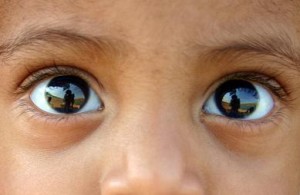Good vision is important for children to be able to read,  write and understand their schoolwork. Those early years are the building blocks to their future. The information they will learn will stick with them forever. If they do not learn it the first time, they will have trouble in the future. Whether the student sits in front of the classroom or in the back, they are likely to look up and down between teacher and textbook to understand the material being taught.
write and understand their schoolwork. Those early years are the building blocks to their future. The information they will learn will stick with them forever. If they do not learn it the first time, they will have trouble in the future. Whether the student sits in front of the classroom or in the back, they are likely to look up and down between teacher and textbook to understand the material being taught.
If a child does not see well, then they may have low self-esteem or feel scared to say that they cannot see the board. This can be troubling for children, because not only will their grades suffer but so will their mentality. Vision is the key to a successful child’s ability to read and learn.
Learning-related Vision Problems
If you thought that a child who has vision problems can be diagnosed immediately, you are wrong. There are different kinds of vision problems. One is when a child’s eyes do not focus together and cause the writing in front of them to be blurred. This is technically called convergence insufficiency. After a short period of time, the eyes begin to strain to read correctly. Even then, the writing is still blurred and scrambled.
Another type of vision problem is called eye tracking. This means that a child is not reading words in the order they are written. Their eyes scramble all over the page, picking up a word or sentence here and there. This can cause confusion and reading trouble.
Focusing, or accommodation disorder, is when a child reads the words in front of them, but has to strain their eyes to do it. The words are blurry and in many cases, usually require reading glasses to fix. Our mind has to focus on the book and the teacher at once. Focusing in and out can be hard for someone who has a vision problem.
Treatment Options and How They Can Help Children
School nurses only check student’s vision for 20/20 vision. This only measures a distance of 20 feet, which in some cases is not enough. Children with vision problems should see an optometrist. If the optometrist is not specialized in children vision problems, they can refer the child to one who is. Optometrists have technology and equipment that can figure out the exact vision problem and prescribe vision therapy or glasses.
Vision therapy is the recommended treatment for children. This is a step-by-step program that improves function and performance in children’s vision. Years of research and testing have been done to make sure that our children are getting the right treatment for their problems. Self esteem will increase, grades will increase and motivation to do better will increase as well.
Sara Roberts writes for Just Eyewear, a discount eyeglasses and prescription sunglasses online retailer.
 Posts
Posts